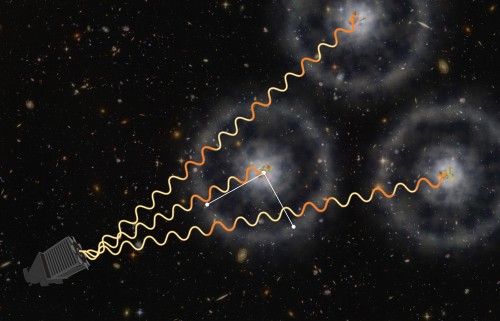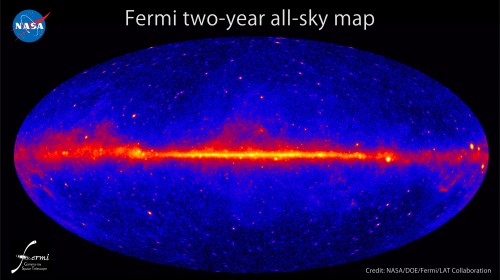Posts by: Calla Cofield
BOSS uses 164,000 quasars to map expanding universe

An artist’s illustration of how BOSS uses quasars to measure the distant universe. (Courtesy: Zosia Rostomian, Lawrence Berkeley National Laboratory; Andreu Font-Ribera, BOSS)
By Calla Cofield at the APS April Meeting in Savannah, Georgia
Scientists looking at data from the Baryon Oscillation Spectroscopic Survey (BOSS), the largest programme in the third Sloan Digital Sky Survey, have measured the expansion rate of the universe 10.8 billion years ago — a time prior to the onset of accelerated expansion caused by dark energy. The measurement is also the most precise measurement of a universal expansion rate ever made, with only 2% uncertainty. The results were announced at a press conference at the APS’s April meeting on Monday, at the same time that the results were posted on the arXiv preprint server.
The rate of universal expansion has changed over the course of the universe’s lifetime. It is believed to have gradually slowed down after the Big Bang, but mysteriously began accelerating again about 7 billion years ago (by rippstein). BOSS and other observatories have previously measured expansion rates going back 6 billion years.
A possible dark-matter bubble

This all-sky image, constructed from two Fermi datasets, shows how the gamma-ray sky appears at energies greater than 1 GeV. (Courtesy: NASA/DOE/Fermi/LAT Collaboration)
By Calla Cofield at the APS April Meeting in Savannah, Georgia
The American Physical Society (APS) April meeting has been taking place in Savannah, Georgia, for the past three days. On Saturday, Tracy Slatyer from MIT spoke to reporters about a paper that she and colleagues posted on arXiv in February, in which they suggest that a mysterious excess of gamma rays surrounding the galactic centre could be explained as dark-matter particle annihilation.
The researchers use what Slatyer calls a “simple” model of dark matter, in which the invisible substance is made up of weakly interacting massive particles (WIMPs) with a mass of about 35 GeV. The model predicts that WIMPs may collide with each other and annihilate, producing gamma rays and either b-quarks or some other mixture of quarks. The Fermi Gamma-ray Space Telescope surveys the entire observable sky for the presence of gamma rays. Fermi’s observation of the plane of the Milky Way revealed that our galaxy is bright with gamma rays, but Fermi has not been able to identify the sources of all those powerful photons. Gamma-ray excesses (more than can be explained by known sources) near the galactic centre have been identified in the Fermi data in the past – most notably at about 130 GeV.
The work presented by Slatyer and her colleagues identifies an excess of gamma rays between 1 and 3 GeV. The researchers say they can see a distinctly spherical, bubble-like collection of photons. Slatyer told reporters that based on the dark-matter model, this spherical shape is not a coincidence – the dark-matter annihilation theory does not hold for a more stretched-out, elongated cluster of gamma rays; nor would it hold if the bubble were not at the centre of the galaxy.